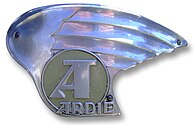Ardie
| Ardie GmbH
|
|
|---|---|
| legal form | Limited Liability Company (from 1922) |
| founding | 1919 |
| resolution | 1958 |
| Seat | Nuremberg , Germany |
| management | Arno Dietrich |
| Branch | Motorcycle manufacturer |
Ardie was a German motorcycle manufacturer from Nuremberg who produced from 1919 to 1958.
history
Founded by Ar no Die trich (Ardie), the company initially limited itself to the production of a single - cylinder two-stroke machine with capacities of 288 and 304 cm³, which was popularly referred to as Ardie Minimax because of its red paint and the shape of the tank .
On September 9, 1922, the founder Arno Dietrich was killed during a test drive in Nuremberg, Rothenburger Strasse. The business was taken over by the Jewish lawyer Leo Bendit and converted into a GmbH.
From 1925, the range was expanded to include a whole range of motorcycles equipped with British 250, 350, 500, 750 and 1000 cc JAP built -in engines .
The car designer Josef Ganz built his first “Volkswagen” prototype here in 1930, the Ardie-Ganz .
In the course of Aryanization , Bendit had to sell its factory in 1933. It went to the Barthel family, the owners of the Dürkopp plants in Bielefeld.
Due to currency restrictions, British engines could no longer be imported, so that Ardie could only install German engines from Bark and Küchen . From 1936 the company devoted itself exclusively to the realization of its own models with 125, 200 and 250 cm³ two-cylinder two- stroke engines.
Decisively responsible for the development of the engines was Norbert Riedel , who was head of the design department and the testing department from April 1938. After the war, Norbert Riedel became famous for his Imme motorcycle .
At the beginning of the war, twelve different motorcycles were manufactured with these engines. In the years that followed, the variety of models was reduced until there were only two products left in 1942: a stationary engine and the VF125 motorcycle, both with a 125 cc engine.
During the Second World War a transversely installed 350 cc two-cylinder with valves hanging in the cylinder head was produced.
After the war, the range was expanded to include a two-stroke engine with 122 and 198 cm³ displacement, a single cylinder with 244 cm³ and a standing two-cylinder with 344 cm³.
In 1958 the company stopped producing motorcycles, but continued to manufacture hydraulic equipment until 1981 .
The factory at Preißlerstrasse 5–15 ⊙ in Nuremberg was taken over in 1978 by the Erlangen precision mechanics, optics and electrical engineering company Frieseke & Hoepfner.
Most recently (2013/14) the factory buildings were converted into a residential complex.
literature
- Erwin Tragatsch : All motorcycles from 1894 to today . Motorbuch Verlag, Stuttgart 1982, ISBN 3-87943-410-7 .
- Tilman Werner: From Ardie to Zündapp . Motorbuch Verlag, Stuttgart 1989, ISBN 3-613-01287-1 .
- Matthias Murko: motorcycle legends . W. Tümmels, new edition Nuremberg 2014, ISBN 978-3-921590-27-0 .
- Thomas Reinwald: Motorcycles from Nuremberg . ZWEIRAD-Verlag, Erlangen 1994, ISBN 3-929136-03-1 .
- Thomas Reinwald: Nuremberg motorcycle industry . Brilon 2002, ISBN 3-86133-299-X .
- Thomas Reinwald: Ardie and Dürkopp motorcycles . Johann Kleine Vennekate, Lemgo 2003, ISBN 3-935517-10-6 .
- Steffen Riedel: Norbert Riedel - History of the "Imme" and other constructions , Podzun 2012, ISBN 978-3-86133-639-6
See also
Web links
- www.ardie.de Homepage of fans of the brand
- www.oldie-schuppen.de Restoration Ardie B252 and RZ 200 "Peter"
- The master things of Nuremberg: Ardie
- Ardie - Historic photo around 1920-30
- Ardie - Historic photo around 1930-40
- Ardie Minimax - blog post showing the details
Individual evidence
- ↑ https://www.gtue-oldtimerservice.de/motorrad/marke/ARDIE/2289/
- ↑ Jewish topography of Nuremberg (English) at rijo-research.de
- ↑ a b http://www.nuernberginfos.de/industrialisierung-in-nuernberg/zweiradindustrie.html
- ↑ THE GERMAN MOTORCYCLE INDUSTRY, SINCE 1938, BY S. du PONT
- ↑ Decades of experience in the development of hydraulic power units on the website of the successor company Luvra
- ↑ For Friesecke & Hoepfner see http://www.erlangen-virtuell.myfen.de/strasse.php?id=280 and decades of experience in the development of hydraulic units on the website of the successor company Luvra
- ↑ See websites Ardie Home and Ardie Living from Schultheiss Wohnbau, accessed on July 27, 2014
Coordinates: 49 ° 27 ′ 7 ″ N , 11 ° 3 ′ 2 ″ E







